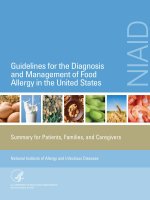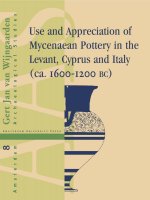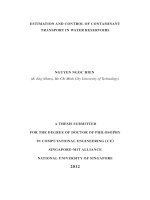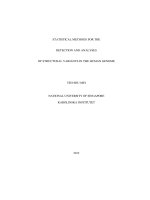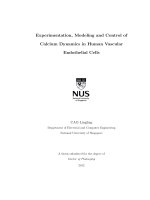Diversity and abundance of pollinators fauna in phalsa Grewia Subinaequalis D.C
Bạn đang xem bản rút gọn của tài liệu. Xem và tải ngay bản đầy đủ của tài liệu tại đây (177.72 KB, 6 trang )
Int.J.Curr.Microbiol.App.Sci (2019) 8(2): 2199-2204
International Journal of Current Microbiology and Applied Sciences
ISSN: 2319-7706 Volume 8 Number 02 (2019)
Journal homepage:
Original Research Article
/>
Diversity and Abundance of Pollinators Fauna in
Phalsa Grewia subinaequalis D.C
Avinash Udikeri* and Umesh Chandra
Department of Entomology , College of Agriculture, Faizabad, Narendra Deva of University
of Agriculture and Technology, Kumarganj, Faizabad-224 229, Uttar Pradesh, India
*Corresponding author
ABSTRACT
Keywords
Pollinators,
Relative
abundance, Phalsa
Article Info
Accepted:
18 January 2019
Available Online:
10 February 2019
A study was carried out to know the diversity and abundance pollinator fauna on Phalsa,
Grewia subinaequalis D.C. a fruiting shrub at Main Experimental Station Horticulture,
Narendra Deva University of Agriculture and Technology, Kumarganj, Faizabad (U.P)
during year 2015. A total of nineteen different insect species were found visiting the
Phalsa flowers. Thirteen insect species belonging to the families Megachilidae (3 spp),
Vespidae (2spp), Apidae (5spp), Halictidae (1sp.), Xylocopidae (2spp.) of the order
Hymenoptera have been recognised as active pollinators of Phalsa. Three Dipterans
belonging to the family sarcophagidae, Calliphoridae and Syrphidae found to pollinate this
fruit crop. Three butterflies which are of Pieridae, Nymphalidae and Amatidae families are
found to visit the flowers of the Phalsa. Apis dorsata, A. mellifera, Megachile spp, Halictus
Sp. were abundant pollinators. The foraging activity started from April month. The
abundance of Halictus sp. was highest with 4.38 bees/branch/5min followed by Megachile
sp. (3.88bees/branch/5min) and A.dorsata (2.89 bees/branch/5min). Dipterans and
Lepidopterans were less abundant.
Introduction
Grewia subinaequalis D.C. (Malvaceae),
commonly known as ‘Phalsa’ is a
multipurpose gregarious shrub, found in
tropical and subtropical parts of India. It is an
invasive species indigenous in the Indian
subcontinent and South-Eastern Asia. The
genus comprises approximately 150 species
of small trees and shrubs, distributed in
subtropical and tropical regions of the world
and it is the only genus in its family that
yields edible fruits (Ullah et al., 2012). Phalsa
is a cross-pollinated fruit crop and pollination
is done by the insects such as honey bees,
wasp, hover flies etc. Phalsa flower comes in
last week of February and the fruits ripe in the
second forth night of April and continuous
upto middle of June.
It is minor fruit and is being cultivated on
very small scale in each state. Phalsa is found
wildly growing in UP, Rajasthan, Punjab,
Haryana, MP, West Bengal and many parts of
south India. The cultivation of Phalsa is
limited to very small scale. Most of the
commercial plantations are adjoining to big
cities. However, in Punjab, Haryana and Uttar
2199
Int.J.Curr.Microbiol.App.Sci (2019) 8(2): 2199-2204
Pradesh it is cultivated near cities
commercially. In Punjab area under Phalsa is
only 30 hectares with annual production of
196 tonnes approximately. The total area
under Phalsa is less than 1000 ha. The
popularity of this crop is restricted due to
small fruit size, prolonged ripening period,
repeated harvesting and highly perishable
nature of fruits.
The current statistics on area and production
of this fruit are not available. Apart from
India it is cultivated in Pakistan, Nepal,
Bangladesh, Laos, Sri Lanka, Thailand,
Philippines, Vietnam and experimental basis
in some provinces of United States of
America.
The fruits are claimed to be useful for heart,
blood and liver disorders. Anorexia,
indigestion, thirst, toxaemia, stomatitis,
hiccough, asthma, spermatorrhoea, fever,
diarrhoea, tuberculosis and sexual troubles are
some other ailments where Phalsa fruits are
effective (Mishra et al., 2012; Pallavi et al.,
2011; Sharma and Sisodia, 2009). Keeping in
view of these important medicinal properties
present investigation was done to know about
which are the important insect species which
help to set the fruits of Phalsa.
Faunistic spectrum of insects visiting the
flowers of Phalsa
The insects visiting phalsa flowers were
keenly observed throughout the blooming
period at weekly intervals during April to
May months at hourly intervals in morning
and noon. These insects were collected by
using a cone type hand net having 30 cm ring
diameter. Swift sweeping method was
adopted to collect the insects and they
specimen were processed for identification.
Identification was done using taxonomic keys
by Dr. Umesh Chandra, Project coordinator,
AICRP on honey bees, NDUAT, Faizabad.
Abundance of insect visitors/pollinators on
Phalsa flowers
Abundance
of
different
insect
visitors/pollinators on Phalsa flowers
mentioned above was studied during their
blooming period. The total number of
different insects visiting on the number of
Phalsa flowers was observed on randomly
selected five plants between 0800-1000,
1000-1200 and 1400-1600 h of the day. These
observations were started at 50 per cent
flowering and continued upto 90% flowering.
The data on relative abundance was
subjected for statistical analyses suitably
Materials and Methods
The investigations were carried in an well
established phalsa plantation (cv.Dwarf
variety) at Main Experimental Station,
Department of Horticulture, Narendra Deva
University of Agriculture and Technology,
Kumarganj, Faizabad (U.P.) Geographically,
it is situated at 26.470 N latitude, 82.120 E
longitude and altitude of 113 metres above
mean sea level. The site is located in typical
saline-alkaline belt of indogangetic plains of
eastern Uttar Pradesh. The experiment site
was having sodic soils. The shrubs of phalsa
were two years old.
All the data pertaining to relative abundance
was statistically analyzed by using
Randomised block design. The effect of bee
pollination on different aspects of yield, the
statistical analyses of data were performed for
analysis of variance as outlined by Gomez et
al., (1984).
From the above analysis, standard error of
mean (SEm±) as well as, critical difference
was calculated at 5% level of probability
calculated to test the significance of mean for
the treatment differences.
2200
Int.J.Curr.Microbiol.App.Sci (2019) 8(2): 2199-2204
Results and Discussion
Documentation of pollinators on Phalsa
Phalsa is cross pollinated fruit crop which
attracts more number of pollinators during its
booming period. Insect visitors and
pollinators collected from Phalsa crop have
been listed in Table 1. A total of nineteen
different insect species belonging to eleven
families from three orders were documented
from the Phalsa flowers.
The Hymenopterans were the major floral
pollinators comprising of thirteen species
from four families viz. Apidae, Vespidae,
Megachilidae, Halictidae and Xylocopidae.
Three species of the families Sarcophagidae,
Calliphoridae, Syrphidae belonging to order
Diptera and three species of families
Nymphalidae, Pieridae, Amatidae belonging
to Lepidoptera were found to be pollinating
the flowers of Phalsa..
Relative abundance of different insect
pollinators
The data on the frequency of different insect
visitors (Total number of bees/branch/5 min.)
irrespective of different plant types have been
presented in Table 2. It revealed that the
pooled averages of all the insect visitors,
irrespective of species, on three observational
hours (0800 to 1000, 1000 to 1200 and 1400
to 1600 h of the day) during first (8th April to
17th April), second (19th April to 28th April)
and third (30th April to 9th May) interval
observations were 2.93, 2.52, 2.24, 3.77, 3.32,
2.88, 2.03, 1.59 and 1.31 number of
bees/branch/5 min., respectively. During first
interval, the frequency of insect visitors
differed significantly.
Halictus sp. was significantly superior over
all the insect species at different hours of the
day. At 1400-1600 h of the day activity of
Apis dorsata was on par with Apis mellifera.
During second interval, Halictus sp. was
significantly superior over all the insect
species at different hours of the day. At 14001600h of the day, activity of Apis mellifera
was on par with the Polistes olivaceus.
During third interval, the activity of Halictus
sp. remained significantly superior compared
to other insects’ species at different hours of
the day. The activity of Apis dorsata was on
par with Apis mellifera at 1000-1200 and
1400-1600 h of the day. The activity of
Halictus sp. was significantly higher at all the
three hours of the day during all the three
intervals which was followed by Megachile
sp., Apis dorsata, Apis mellifera, Polistes
olivaceus, Dipterans and Lepidopterans.
Irrespective of three observational hours,
Halictus sp. with 4.66, 5.60 and 2.86
bees/branch/5 min was the most abundant
forager followed by Megachile sp. with 4.08,
5.05 and 2.53 bees/branch/5min. The
lepidopteran at 0.59, 0.85, 0.41insects/
branch/5min and dipteran 0.62, 1.15, 0.60
insects/branch/5min were significantly lower
than the Apis dorsata 2.8 and 1.78
bees/branch/5min during all three intervals.
The interaction between the insect visitors
and hours showed that in first and third
interval have lower insect abundance when it
is compared with than second interval
throughout the period of observations.
Documentation of pollinators on Phalsa
Present findings of diversity of pollinators are
in line with Gill (2001) who documented a
total number of 21 insect species
(Hymenoptera 10; Lepidoptera 7 and Diptera
4) from the flowers of Phalsa, among these
Apis florea F. Apis mellifera L., Apis dorsata
F. Megachile bicolour F. and Chalicodoma
cephalotes smith were observed foraging on
both nectar and pollen.
2201
Int.J.Curr.Microbiol.App.Sci (2019) 8(2): 2199-2204
Table.1 Documentation of various insect pollinators on Phalsa flowers 2015
Common name
Leaf cutter bees
Yellow banded
wasp
Common paper
wasp
Italian bee
Giant bee
Indian bee
Little bee
Stingless bee
Sweat bees or
Halictid bees
Carpenter bees
Flesh fly
Hover fly
Pioneer white
African monarch
Scientific name
Megachile lanata
Coelioxys apicata
Megachile sp.
Vespa orientalis
Family
Megachilidae
Order
Vespidae
Polistes olivaceus
Apis mellifera
Apis dorsata
Apis cerena indica
Apis florea
Tetragonula
iridipennis
Halictus spp.
Apidae
Xylocopafenestrate
Xylocopa
pubescence
Sarcophaga spp.
Chrysomya spp.
Eristalinus
tabanoides
Anaphaeis aurota
Danaus
chrysippus
Amata passelis
Xylocopidae
Hymenoptera
Halictidae
sarcophagidae
Calliphoridae
Syrphidae
Pieridae
Nymphalidae
Amatidae
2202
Diptera
Lepidoptera
Int.J.Curr.Microbiol.App.Sci (2019) 8(2): 2199-2204
Table.2 Relative abundance of different insect pollinators on Phalsa during 2015
Number of pollinators / Branch/5 minutes during different day hours
Insect
Pollinators
8 April to 17 April
19 April to 28 April
30 April to 09 May
08.0010.00
10.0012.00
14.0016.00
Mean
08.0010.00
10.0012.00
14.0016.00
Mean
08.0010.00
10.0012.00
14.0016.00
Mean
3.44
(1.98)
2.86
(1.83)
2.30
(1.67)
2.87
(1.83)
4.74
(2.29)
3.83
(2.08)
3.37
(1.97)
3.98
(2.11)
2.86
(1.83)
1.43
(1.39)
1.18
(1.29)
1.82
(1.51)
A.mellifera
3.02
(1.87)
2.61
(1.76)
2.14
(1.62)
2.59
(1.75)
3.99
(2.11)
3.47
(1.99)
2.98
(1.86)
3.48
(1.99)
2.11
(1.61)
1.39
(1.37)
1.10
(1.26)
1.53
(1.42)
Halictus sp
5.21
(2.39)
4.54
(2.24)
4.22
(2.17)
4.66
(2.27)
6.32
(2.61)
5.56
(2.46)
4.92
(2.33)
5.6
(2.47)
3.16
(1.91)
2.96
(1.86)
2.46
(1.72)
2.86
(1.83)
Polistes
olivaceus
2.84
(1.82)
2.41
(1.70)
2.35
(1.68)
2.53
(1.74)
3.53
(2.00)
3.18
(1.91)
2.78
(1.81)
3.16
(1.91)
1.95
(1.56)
1.81
(1.51)
1.51
(1.41)
1.76
(1.50)
Megachile sp.
4.74
(2.29)
4.02
(2.13)
3.49
(2.00)
4.08
(2.14)
5.61
(2.47)
5.1
(2.36)
4.43
(2.22)
5.05
(2.35)
2.80
(1.89)
2.55
(1.75)
2.22
(1.64)
2.53
(1.74)
Lepidoptera
0.62
(1.06)
0.64
(1.07)
0.50
(1.00)
0.59
(1.04)
1.00
(1.22)
0.87
(1.17)
0.67
(1.08)
0.85
(1.16)
0.64
(1.06)
0.35
(0.92)
0.23
(0.85)
0.41
(0.95)
Diptera
0.64
(1.07)
0.56
(1.03)
0.67
(1.03)
0.62
(1.04)
1.20
(1.30)
1.23
(1.31)
1.01
(1.23)
1.15
(1.28)
0.69
(1.09)
0.64
(1.07)
0.47
(0.98)
0.6
(1.05)
Mean
2.93
(1.76)
2.52
(1.66)
2.24
(1.59)
3.77
(1.98)
3.32
(1.87)
2.88
(1.76)
2.03
(1.54)
1.59
(1.40)
1.31
(1.30)
A.dorsata
SEm±
0.054
0.067
0.049
CD at 5%
0.158
0.195
0.142
Figures in the parenthesis are square root transformed values
2203
Int.J.Curr.Microbiol.App.Sci (2019) 8(2): 2199-2204
Relative abundance of different insect
pollinators
The maximum activity of the insects can be
seen morning and noon session this results
coincides with work of Randhawa and Dass
(1962) and Parmar (1976) who recorded
maximum activity of floral visitors in Phalsa
was during 8.00AM to 12.00 Noon. After that
there are no studies on pollination activity in
Phalsa. However, over the years there reliance
of insect pollinators on Phalsa has remained
unchanged strikingly.
Halictus sp. was found most abundant
followed by Megachile sp. And Apis
dorsata.The present study justifies the
observations of Kumar (2010) who reported
that Halictus sp. as most abundant visitor
among three bee species. Similarly Trigona
spp., Halictus sp. and lepidopterans were the
most frequent visitors among the different
insect pollinators on M. charantia flowers in
Philippines as per Deyto and Cervancia
(2009).
References
Deyto, R.C. and Cervancia, C.R. (2009).
Floral biology and pollination of
Ampalaya (Momordica charantia L.).
Philipp. Agri. Scientist, 92(1): 8-18.
Gill, S. S., Kaushik, H. D. and Sharma S. K.
(2001). Effect of modes of pollination
on fruit set and insect pollinators of
Phalsa (Grewia subinaequalis D. C.).
Res. on Crops 2 (2): 193-196.
Gomez, K.A. and Gomez, A.A. (1984).
Statistical procedures, John Wiley and
sons, Pp. 644-655.
Kumar, B.P. (2010). Studies on insect
pollinators
on
Bitter
gourd
(Momordica charantia L.) M.Sc.
Thesis,
Haryana
Agricultural
University, Hisar, Haryana, India,
15pp
Mishra, R.K., Patel, S.P., Srivastava, A.,
Vashistha, R.K., Singh, A. and Puskar,
A.K.
(2012)
Ethnomedicinally
important plants of Pachmarhi region,
Madhya Pradesh, India. Nat. Sci J.10,
22–26.
Pallavi, K., Singh, R., Singh, S., Singh, K.,
Farswan, M. And Singh, V., (2011).
Aphrodisiac agents from medicinal
plants: a review. J. Chem. Pharm. Res.
3, 911–921.
Parmar, (1976). Pollination and fruit set in
Phalsa (Grewia asiatica L.) Agri.
Agro. Industries, J. 9 (6): 12-14.
Randhawa, G. S. and Dass, H. C. (1962).
Studies on floral biology of Phalsa
(Grewia astiatica L.) Indian J. Hort.
19(1): 10-24.
Sharma, K.V. and Sisodia, R. (2009).
Evaluation of the free radical
scavenging
activity
and
radioprotective efficacy of Grewia
asiatica fruit. J. Radiol. Prot. 29, 429–
443.
Ullah, W., Uddin, G. and Siddiqui, B.S.
(2012). Ethnic uses, pharmacological
and phytochemical profile of genus
Grewia. J. Asian Nat. Prod. Res. 14,
186–195.
How to cite this article:
Avinash Udikeri and Umesh Chandra. 2019. Diversity and Abundance of Pollinators Fauna in
Phalsa Grewia subinaequalis D.C. Int.J.Curr.Microbiol.App.Sci. 8(02): 2199-2204.
doi: />
2204


